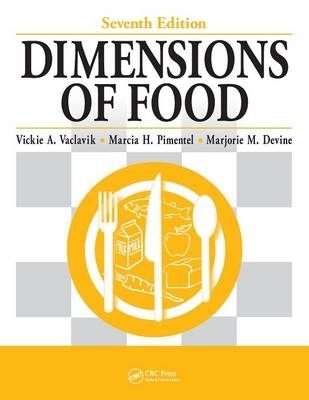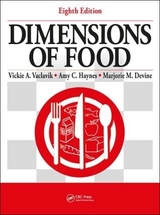
Dimensions of Food, Seventh Edition
Crc Press Inc (Verlag)
978-1-4398-2167-1 (ISBN)
- Titel erscheint in neuer Auflage
- Artikel merken
Much like its popular predecessors, the seventh edition of Dimensions of Food encourages readers to become interactive participants in understanding the physical, chemical, and functional and structural properties of food components, including the connection between conscientious food preparation and palatability and wholesome eating.
With a wealth of questions, charts to complete, and practical exercises, this four part workbook allows readers to explore and develop a deeper understanding of food in ways that will maximize each of their own culinary experiences.
Part One leads readers through an investigation of the economic, nutritional, palatability, sanitation, chemical, and processing dimensions of food.
Part Two provides a number of demonstrations and participatory exercises that will help develop a basic understanding of the functional and structural properties of a variety of food groups that include starches, fruits and vegetables, eggs, dairy, meat, poultry, fish, fats and oils, and sugars and baked products.
Part Three focuses an analytical eye on the modern convenience of microwave cookery, detailing effective procedures for cooking, reheating, and defrosting food.
Part Four gives readers the opportunity to creatively apply the principles of food selection so as to prepare meals that that are personally satisfying, nutritious, and practical.
Revised and updated to include new information and current trends, this resource:
Offers an expanded discussion of food allergies and intolerances
Includes sample scorecards for evaluating foods, as well as a sample nutrition facts label
Accesses new website information on calibrating a thermometer
Emphasizes how to preserve both the nutritional value and the palatability of food
Adds new exercises and problems to facilitate the learning of key principles
Provides18 detailed appendices that cover everything from foodborne illness, allergies, and cooking regulations, to dietary guidelines, cooking terms, buying guides, and dessert websites
Designed with perforated pages, extra space for specialized lessons, and plenty of opportunity for user input, this book will allow each reader to create a personalized reference for their continued use and enjoyment.
University of Texas Southwestern Medical Center, Dallas, USA & UT Southwestern Medical Center, Dallas, TX, USA Senior Lecturer, Retired, Cornell University, Ithaca, New York, USA Professor Emeritus, Cornell University, Ithaca, New York, USA
DIMENSIONS OF FOOD
A. Economic Dimensions
Exercise 1: Factors Influencing the Cost of Food
A. Quality of Product—Comparing Store and National Brands
B. Caloric and Price Differences of Various Product Formulations
C. The Cost of Convenience Foods—Ready-to-Eat Products, Packaged Mixes
D. Comparing Price per Serving of Various Forms of a Food
E. Cost Comparison of Food, As Purchased (A.P.) and Edible Portion (E.P.)
Exercise 2: Labels as Guides in Food Purchasing
Exercise 3: "Health" Food
Exercise 4: Planned-Over Foods
Summary Questions—Economic Dimensions
B. Nutritional Dimensions
Exercise 1: Determining Serving Size
Exercise 2: Factors Affecting Caloric Value of Foods
Exercise 3: Nutrient Contributions of the Food Pyramid
Exercise 4: Evaluation of a Daily Menu
Exercise 5: Labels as Guides to Nutrient Content
A. Nutritive Value and Cost of Fruit-Juice Products
B. Carbohydrate Label Information
C. Nutritive Value and Cost of Cereal Products
D. Health Claims Allowed on Labels
E. Food Allergies
Summary Questions—Nutritional Dimensions
C. Palatability Dimensions
Exercise 1: Identifying Sensory Properties of Food
Exercise 2: Sensory Evaluation Tests
Exercise 3: Evaluating Sensory Properties in Foods
Exercise 4: Evaluating Food Products Marketed for Use with Food Allergies
Exercise 5: Evaluating Personal Preferences
Summary Questions—Palatability Dimensions
D. Chemical Dimensions
Exercise 1: Functions of Food Additives
Exercise 2: Relationship of Additive Use to Degree of Processing
Exercise 3: Evaluation of Snack Foods
Exercise 4: Sodium Content of Foods
Exercise 5: Wheat in Foods
Summary Questions—Chemical Dimensions
E. Sanitary Dimensions
Exercise 1: Factors Affecting the Microbial Safety of Foods
A. Sources of Contamination
B. Conditions Necessary for the Growth of Bacteria
C. Bacterial Growth Curve
Exercise 2: Temperature Control in Food Handling
A. Factors Affecting the Rate of Cooling of Large Quantities of Foods
B. Temperatures for Holding and Reheating Foods
C. Recommended Temperatures for Cooked Food
Exercise 3: Sanitization in the Food Preparation Environment
A. Use of Approved Chemical Sanitizers
B. Sanitization by Immersion
Summary Questions—Sanitary Dimensions
F. Food-Processing Dimensions
Exercise 1: Processing Temperatures
Exercise 2: Food Processing, Canning
A. Canning Equipment
B. Canning Acid and Low-Acid Foods
Questions—Canning
Exercise 3: Food Processing, Freezing
A. Freezing Equipment
B. Freezing Fruits and Vegetables
Questions—Freezing
Summary Questions—Dimensions of Food (Part I, A–F)
FOOD PRINCIPLES
A. Measurements, Use of Ingredients, Laboratory Techniques, Policies, and Procedures
Exercise 1: Demonstration of Measuring and Mixing Techniques
Exercise 2: Measuring Liquids
Exercise 3: Measuring Solids
Exercise 4: Cleanup
Summary Questions—Measurements, Use of Ingredients, and Laboratory Techniques
Lab Policies and Procedures
B. Cereal and Starch
Exercise 1: Separation of Starch Granules
Exercise 2: Properties of Wheat and Cornstarch
Exercise 3: Effect of Sugar and Acid on Gelatinization
Exercise 4: Application of Principles to Starch-Thickened Products
Exercise 5: Preparing Cereal Products
Cereal Recipes
Summary Questions—Cereal and Starch
Dietitian’s Note
C. Fruits and Vegetables
Exercise 1: Properties of Parenchyma Cells
A. Components of Parenchyma Cell
B. Recrisping Succulents
Exercise 2: Fruits
A. Enzymatic Browning
B. Effect of Sugar on Texture and Flavor of Cooked Fresh Fruit
C. Effect of Sugar on Texture and Flavor of Cooked Dried Fruit
D. Factors Affecting Anthocyanin Pigments
Exercise 3: Cooking Vegetables
A. Effect of pH on Pigments and Texture
B. Effect of Cooking Procedure on Pigments and Flavors
C. Application of Principles to Cooking a Variety of Vegetables
Evaluation of Vegetable Recipes
Nutritive Value of Assigned Recipe(s)
Vegetable Recipes
Uncooked Vegetables and Fruit
Recipe Questions—Fruits and Vegetables
Summary Questions—Fruits and Vegetables
Dietitian’s Note
D. Meat, Poultry, and Fish
Exercise 1: Identification of Basic Meat Cuts
Exercise 2: Effect of Dry and Moist Heat on Less Tender (Tough) Cuts of Meat
A. Roasts
B. Meat Patties
Exercise 3: Evaluation of Meat, Poultry, and Fish
Meat, Poultry, and Fish Recipes
Summary Questions—Meat, Poultry, and Fish
Dietitian’s Note
E. Plant Proteins
Exercise 1: Pretreatment and Cooking Methods for Legumes
A. Pretreatment
B. Cooking Methods
Exercise 2: Combining Plant Proteins
Evaluation of Plant Protein Recipes
Plant Protein Recipes
Summary Questions—Plant Proteins
Dietitian’s Note
F. Eggs and Egg Products
Exercise 1: Egg Quality
Exercise 2: Coagulation of Egg Protein in Baked and Stirred Custard
Basic Egg Custard—for Baked and Stirred Custard
Exercise 3: Egg White Foams
Exercise 4: Effect of Added Substances on Egg White Foam
Exercise 5: Effect of Cooking Intensity on Egg Protein
Methods of Cooking Eggs
Exercise 6: Characteristics of Cooked Modified Egg Mixtures
Exercise 7: Combining Starch and Eggs as Thickeners in One Product—Souffle
Souffle Recipes
Exercise 8: Other Egg Recipes
Summary Questions—Eggs and Egg Products
Dietitian’s Note
G. Milk and Milk Products
Exercise 1: Comparison of Milk and Nondairy Products
Exercise 2: Coagulation of Milk Protein
A. Addition of Acid
B. Acid Produced by Bacteria (Yogurt)
C. Enzyme Action (Rennin)
Exercise 3: Combining Acid Foods with Milk
Exercise 4: Comparison of Cheese Products
Exercise 5: Effect of Heat on Natural and Processed Cheese
Summary Questions—Milk and Milk Products
Dietitian’s Note
H. Fats and Oils
Exercise 1: Separation and Ratio of Oil and Acid; Emulsifiers
Exercise 2: Application of Principles to Salad Dressings
Salad Dressing Recipes
Exercise 3: Fat-Free, Fat-Reduced, and Fat-Replaced Products
A. Calories, Cost, and Palatability of Foods with Various Fat Levels
B. Fat-Replacement Ingredient Labeling
Exercise 4: Comparison of Dietary Fats
Summary Questions—Fats and Oils
Dietitian’s Note
I. Sugars, Sweeteners
Exercise 1: Methods of Initiating Crystallization
Exercise 2: The Relationship of Sugar Concentration to Boiling Point
Exercise 3: Effect of Temperature and Agitation on Crystal Size
Exercise 4: Effect of Interfering Agents on Sugar Structure
Exercise 5: Alternatives to Sugar
Summary Questions—Sugars, Sweeteners
Dietitian’s Note
J. Batters and Dough
Exercise 1: Measurement of Flour
Exercise 2: Structural Properties of Wheat Flour
Questions—Gluten
Exercise 3: Chemical Leavening Agents
A. Ingredients of Baking Powders
B. Comparison of Speed of Reaction
Exercise 4: Factors Affecting the Leavening Power of Yeast
Questions—Leavening Agents
Exercise 5: Drop Batters, Muffins
A. Effect of Manipulation
B. Effect of Different Grains
Questions—Muffins
Exercise 6: Soft Dough, Biscuits
A. Effect of Manipulation
B. Substituting Soda Acid for Baking Powder
Questions—Biscuits
Exercise 7: Pancakes, Popovers, Cream Puffs, Crepes
A. Effect of Manipulation on Gluten Development in Pancakes
B. Effect of Manipulation on Gluten Development in Popovers
C. Cream Puffs
D. Crepes
Evaluation of Crepes
Questions—Pancakes, Popovers, Cream Puffs, Crepes
Exercise 8: Stiff Dough—Yeast Breads/Rolls
Evaluation of Yeast Rolls
Questions—Yeast Breads/Rolls
Exercise 9: Shortened Cakes
A. Effect of Manipulation and Type of Shortening on Cake Texture
Conventional Method of Mixing
Dump Method of Mixing
Evaluation of Cakes
Questions—Cakes
Exercise 10: Stiff Dough—Pastry
A. Effect of Different Fat Plasticities on Palatability of Pastry
B. Effect of Different Fillings on Palatability of Bottom Crust
Questions—Pastry
Summary Questions—Batters and Doughs
Dietitian’s Note
HEATING FOODS BY MICROWAVE
Microwave Cooking
Exercise 1: Effect of Cooking Procedure on Pigments and Flavors
Exercise 2: Fruits
Exercise 3: Vegetables
General Directions
Exercise 4: Starch Products
A. Pasta, Rice, and Cereals
B. Flour and Cornstarch as Thickeners
Exercise 5: Eggs
Exercise 6: Meat, Poultry, and Fish
Exercise 7: Batters and Dough
Exercise 8: Reheating Baked Products
Exercise 9: Defrosting
Summary Questions—Microwave Cooking
MEAL MANAGEMENT
Meal Management
Exercise 1: Analyzing Menus for Palatability Qualities
Exercise 2: Economic Considerations in Menu Planning
Exercise 3: Low-Calorie Modifications
Exercise 4: Meal Planning
Procedure for the Meal Preparation
Worksheet A: Market and Equipment Order
Worksheet B: Planning Schedule
Worksheet C: Summary Analysis of Meal Plan
Exercise 5: Meal Preparation
Student Evaluation of the Prepared Meal
Exercise 6: Restaurant Meals—Food-Ordering Practices
Summary Questions—Meal Management
Appendices
Appendix A: Legislation Governing the Food Supply
Appendix B: Food Guides and Dietary Guidelines
Appendix C: Some Food Equivalents
Appendix D: Average Serving or Portion of Foods
Appendix E: Food Allergies
Appendix F: Food Additives
Appendix G: pH of Some Common Foods
Appendix H-1: Major Bacterial Foodborne Illnesses
Appendix H-2: Meat- and Egg-Cooking Regulations
Appendix I: Heat Transfer
Appendix J: Symbols for Measurements and Weights
Appendix K: Notes on Test for Presence of Ascorbic Acid
Appendix L-1: Cooking Terms
Appendix L-2: Cuisine Terminology
Appendix M: Buying Guide
Appendix N: Spice and Herb Chart
Appendix O: Plant Proteins
Appendix P: Websites—Frozen Desserts
| Erscheint lt. Verlag | 11.2.2010 |
|---|---|
| Zusatzinfo | PPI 444; 176 Tables, black and white; 101 Illustrations, black and white |
| Verlagsort | Bosa Roca |
| Sprache | englisch |
| Maße | 219 x 276 mm |
| Gewicht | 1006 g |
| Themenwelt | Medizin / Pharmazie ► Gesundheitsfachberufe ► Diätassistenz / Ernährungsberatung |
| ISBN-10 | 1-4398-2167-4 / 1439821674 |
| ISBN-13 | 978-1-4398-2167-1 / 9781439821671 |
| Zustand | Neuware |
| Haben Sie eine Frage zum Produkt? |
aus dem Bereich



